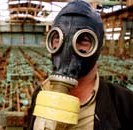Sumgait was once the industrial hub of chemical and heavy metal production in the Soviet Union. It had over 33 factories employing hundreds of thousands of workers, who were housed just one km from where the 300,000 tonnes of toxic waste produced each year was stored. Ten years after the collapse of the Soviet Union, 70% of the population has some form of chemical-related illness.
Situated on the Caspian coast, Sumgait is 35 km north of the capital, Baku. It is the third largest city in Azerbaijan, with a population of 350,000. It was first developed as a factory town in the 1940s and, due to the Soviet's involvement in the Second World War, it soon became one of the USSR's largest and most important industrial complexes in chemical and metallurgical production.
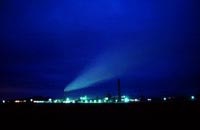 |
| The Sumgait skyline |
Located at a junction of nations and benefiting from freely available oil and gas and cheap hydroelectricity, exports were sold throughout the vast supply and distribution networks of the Soviet Union, Central Asia and the Caucasus. Named the "City of tomorrow," it soon became a boom town, producing 40% of the steel made in the Caucasus.
A huge aluminium plant was built, along with factories for synthetic rubber, fertilisers, industrial detergents, heavy metals, chlorines and acids. Young people flocked from rural areas to fill the plentiful and well-paid jobs; housing was easily available in the numerous five-story apartment blocks built around the factories.
Although most factories are now closed, an illegal business continues; workers are paid with industrial chlorine, which people store at home and sell on the streets. In an effort to clean up the mess left behind, the Azeri government, in conjunction with the United Nations Industrial Development Programme, has declared it an economic free zone, hoping to attract foreign investors to revive the onetime Caucasus tiger.
Where the babies go to die
In a darkened room, where rows and rows of beds line the floor, little faces stare back at us. "Have you seen the cot in the corner? It is where the babies go to die," Sarah, an American member of the International Women's group, says as she points to a small mosquito-net covered cot. "We bought them nets, as the flies were just eating them alive."
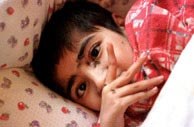 |
| A child in the state-run childrens' home |
This is just one of many rooms in the state-run home for mentally ill children that house hundreds of Azerbaijan's post-Soviet industrial legacy. The rest of the legacy can be seen in the thousands of unmarked graves in the overgrown children's cemetery, which is physical proof that Azerbaijan once had the highest child mortality rate in the world.
Today, Sumgait is an ecological disaster zone. The population is plagued with premature deaths, and unknown diseases will affect generations to come. Fortunately, Azerbaijan does not have the nuclear waste grounds of other Newly Independent States (NIS), but it has had chemical cocktails spewed into the air and polluted water dumped into the environment every day for decades.
During the development years, nobody paid attention to environmental issues. The centralised system from Moscow emphasised on extraction of raw materials, and huge industrialisation projects were undertaken without regard for human life or ecology. The laws that were in place to protect the land and people were so stringent they were covered up, lied about or simply ignored. People were told that the pollution levels were the same as those in the West.
Nature resources were considered inexhaustible and, as the vast Soviet Union spanned eleven time zones, more could always be found elsewhere. Nature was left to take care of itself.
Only about half of the 300,000 tonnes of toxic waste produced each year was recycled; the rest was either left around factories or transported to the city dumps. Between 70,000 and 130,000 tonnes of harmful waste were also burnt in special furnaces, which released toxins directly into the atmosphere.
Accurate records are hard to find, and there is still an ongoing case investigating where several hundred tonnes of mercury-laced building material has gone. The city dump, which also takes 250,000 tonnes of consumer waste, was not built for the overwhelming amounts it has been forced to accommodate, and leaching has poisoned the groundwater and nearby food growing plots.
The city's dilapidated sewage plants are also in need of repair, and most of the city's raw waste is dumped directly into the Caspian Sea. This has created a "dead zone" extending 25 km into once prime fishing grounds for sturgeon fish, the world's quickly dwindling source of caviar.
The politics of business
In 1991, with the collapse of the Soviet Union, the sales and markets dried up. With the isolation and breakdown of transport routes and trade between Russia's southern states, entire factories were forced to close because of a dwindling supply of raw materials from one state or just a lack of certain machine parts from another.
When Communist systems were transformed into a market economies, free fuel was no longer available, industries literally ground to a halt and thousands of people were laid off work. Azerbaijan had gained independence, but its economy was in tatters. A land dispute broke out in with Armenia Nagorno Karabagh, which ensured war for several years and created over a million refugees—60,000 of whom moved to Sumgait.
In an attempt to drive them out, the city was the scene of some of the most brutal murders of resident ethnic Armenians, although there are many tales of Azeri neighbours sheltering friends.
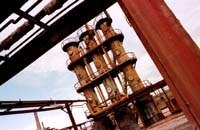 |
| An old chlorine factory |
Since 1988, Octy Tagiyev has been the ecologist at Chlorine plant No 2, a crumbling but still functioning factory employing 1500 people—although it originally employed 5000. Huge, rusting pipes hang above crumbling concrete and the maze of industrial steel below. The sky is grey, and a rancid, throat-burning air fills the lungs with each breath and subtly stings the eyes.
"We have few problems now, but that is because the factory is down to only 20%. I helped to clean up the land and air here, and we even have some trees growing back. We make caustic soda, hydrochlorine and chloride acid. There is a programme to help the workers make extra money. We give them extra chemicals to sell in the markets. They are not dangerous to handle, but they are illegal to sell on the street."
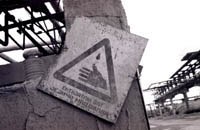 |
| Factory closed |
Only seven or eight factories work nowadays, and those are down to minimum production, at around 7 to 20% of potential output, yet they still employ thousands of workers. The World Bank estimates that 20% of Azerbaijan's population is extremely poor, and 62% are living in poverty; GDP is USD 318.50 per capita per year, or USD 26.50 per month. In the early 1990s, in a manner reminiscent of the old gold rushes, the world's energy companies rushed to Baku, this time for black gold.
The local oil industry was saved in 1994 by a USD 7.4 billion oil development pact—"a deal of the century." This followed predictions that the Caspian could dwarf Saudi Arabia's output. People braced themselves for a new oil boom. It's yet to happen. If it has, unlike in the Arab states, the general population hasn't noticed or felt the benefits.
It isn't only the land that has suffered. Over 70% of the population is affected by ailments connected with working in the factory or the environmental conditions. Many of the chemicals produced were known carcinogens, including hexachlorinated compounds, DDT, Lindane and caustic soda. Prolonged or even indirect contact with these elements can affect internal organs, bones and immune systems; others clearly produce severe reproductive abnormalities. On average, 27 out of 1000 newborns fail to survive more than a year.
Still-births and aborted foetuses are an accepted common occurrence for parents. Birth defects, such as blindness, Downs syndrome, anencephalia (no brain), spina bifida (absence of vertebra arches), hydrocephalus (enlarged head with excessive fluid), bone disease and mutations, are all too common. 62% of children suffer from asthma, and many suffer multiple defects. The relationship between pollution and the human toll is clear, but even doctors and scientists do not know the nature of the relationship; they have had no money or opportunity to research which chemicals or combinations of exposures relate to which illness.
Dr Z J Ismayilov is a respected leader in his field of cancer research and toxicology. In the pathology lab, a woman pulls a bucket from the floor and, using large tweezers, flops a severed woman's breast onto a tray and proceeds to slice a sample off with a kitchen knife. A patient who is in the same room turns and grimaces. The doctor looks tired as he pulls on a cigarette, taking a break from the endless stream of patients waiting to see him.
 |
| State-run childrens' home |
"For workers who have lived in these conditions for 10 to 15 years, there will be work-related illnesses, even if they do not show symptoms now. Toxins enter and change the mechanics of genetics. It actually affects the genetic makeup, resulting in changes in foetuses' genes. It may even skip generations. This is only the start of the problem, and it will get worse. We have the skills and knowledge but lack funds; there is a lot of talk with international organizations, such as the UN, but little action has been taken. We have a chance to save future generations but we need action now," Dr Ismayilov lamented.
Blind love
Firuza fell in love with Sabir immediately upon hearing him play the piano at a wedding. They met, she made him dinner and they asked their parents for permission to marry. They had too little money for a ring but had a party to celebrate. But Firuza has never seen Sabir, and vice versa. Both have been blind from birth, a common problem in Sumgait. So common that the band Sabir plays in is a blind band.
"He used to write me love letters in Braille, but I never replied until my parents agreed. I like to work and used to work at a factory for blind people making garments, but it closed down. Now I just help neighbours with housework. Sabir still plays in the band, and we are trying for children—the last was stillborn," Firuza explained.
Around the markets of the town center, stall holders bustle like in any other town, selling produce out of the backs of cars, bunches of herbs out of petticoats and watermelons out of the back of trucks. Amid the noise, old women can be heard shouting, "Chlori, Chlori," a yellow-tinged liquid sold in jerry cans, jars or old Coca-Cola bottles. Similar little stalls can be found in old truck containers or wooden shacks at most street corners. These are the chlorine sellers.
At the Department for Hygienic and Professional Diseases, Dr Hussianov Vadgid waves his hands and points to a periodic table of elements on the wall, describing what he believes happens when combined chemicals affect the human body. The department used to be the first on the scene at accidents and emergencies in the factories.
"We used to have a 24-hour rescue team, but that closed in 1991. We still carry out low level research but have no funding. The latest phenomenon is the selling of chemicals on the street. Most popular is Hypochloride, which people use as a household cleaner. Factories often cannot pay their workers, so they give them extra stock to sell outside. It is a very dangerous chemical. It burns the skin, causes eye damage and breathing difficulties. They store it at home in kitchens, bathrooms and around children. The police do nothing, because they know that people have no other choice."
Acid bath
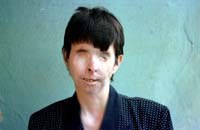 |
| Isenim Isayeva |
It was the chemicals bought from one of these street stalls that changed Isenim Isayeva's life forever. In 1996, she walked into her home to find a man in the act of murdering her five-year-old daughter. After a struggle, she saw it was her brother in law. She stood stunned, as he threw acid in her face and fled. She was horrifically burnt, it sealed her nose, rendered her blind and melted her eyelids shut.
As she recalled the incident, a tear struggled to get out. After recovering in hospital, she found out that her daughter had not survived. The man was caught and, upon questioning, it transpired that it was a plot involving her sister to scare them out of the house so that they could move in. The man managed to escape from jail but was later killed by police in a shoot-out. The sister was freed, because she was the only one able to look after her own child.
Isenim and family moved into a small, cheap flat, and her husband soon fell ill after years of working in the factories. They are struggling to keep food on the table and the children in school.
"It is simple. Before I could see, and now I cannot. I just cannot except this situation. I wish there was a miracle; my only wish is to see my children grow," Isenim said. There may still be a miracle. Isenim's eyes are still light sensitive, and doctors believe she could regain her sight if operated on abroad. The miracle would cost USD 38,000; more than she or even the government can afford.Stagnating environmentalists
Azerbaijan's environmentalists stand in a difficult position. "Morally, how can we talk about planting trees when people barely have enough bread to survive?" Ali Guldosti, of the Green Movement, pondered.
But improvements have been made. In the aluminium factory, retirement is mandatory after ten years, pregnant women can be transferred to positions with less exposure and workers are not allowed to grow crops on the factory grounds anymore. In Soviet times, workers at factories were compensated with milk, cheese and meat, yet this was often grown and raised on the same toxic land.
Environmentalists and the government have managed to close down some of the worst offenders, such as the Lindane plant, and there are plans underway to upgrade the city's wastewater management.
But real change requires huge capital aid and international financing. The World Bank, the EU, the Islamic Bank and the European Bank for Reconstruction and Development have all been active in making a start. As early as 1995, the Azerbaijan government requested that the United Nations Industrial Development Organisation (UNIDO) draft a city plan to restructure the entire chemical sector.
The government is also implementing a Sumgait Development Law that will pave the way for a Special Economic Zone (SEZ), which, it is hoped, will attract much-needed foreign investment, aid and redevelopment.
The SEZ would offer incentives such as cheap land, protection of investments, guaranteed revenue repatriation and a large skilled work force. It aims to regenerate old plants, start medium and small businesses and attract new enterprises to the zone. It will also focus on restructuring transport routes by land, sea and air, improving storage and processing plants and on providing administrative and financial services.

|
Arif Islamzadeh, chief advisor for ecological problems to the Mayor of Sumgait, believes the solution lies in converting the existing structures to produce new products or technology, such as machinery, building equipment, electronics or even robots.
A rebirth?
The rebirth of Sumgait would turn one of the most polluted and ecologically devastated regions of the NIS into a reformed commercial transit point between West and East. Perhaps recognizing the potential, the US administration's strategic policy has long been to "create sovereign democratic law-governed states with a market economy closely integrated into global finance" in Central Asia.
Interestingly, when concerns were raised about the vast costs of the proposed Baku to Ceyan oil pipeline, company officials pointed to "a distinction between the strict commercial nature of oil exports and the geo-strategic aspect of pipeline projects." They claim it is needed to tie the countries of the Caucasus and Central Asia to the West, even if the cost is high.
Sumgait could provide the backbone to an envisaged "Eurasian transportation Corridor," which would eliminate trade barriers and create a region-wide marketplace. This would then lay the groundwork for the possibility of a Central Asian free economic zone, opening up huge consumer market potential for the world's global industries in the process.
The Caucasus has always been a volatile place, where Islam meets Christianity and where Asia joins Europe. Time will tell if Sumgait can regain its former glory.
 |
| Laughter is the best medicine |
There is a joke Azerbaijanis tell about their compatriots from Sumgait. During the Second World War, the Germans were about to execute several men from the town using gas, so they put them in a chamber. After several minutes, they opened the door to find the men shouting at them to shut the door again, because the air was so refreshing to them.
Alex Smailes, 22 January 2001
Moving on:
- Read about Alex Smailes' journey across the Caucasus
- Browse through the CER eBookstore for electronic books
- Buy English-language books on Central and Eastern Europe through CER
- Return to CER front page



